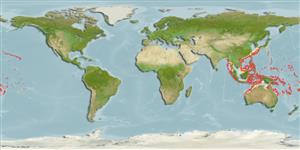>
Eupercaria/misc (Various families in series Eupercaria) >
Lutjanidae (Snappers) > Etelinae
Etymology: Pristipomoides: Greek, pristis = saw + Greek, poma, -atos = cover, operculum + Greek, oides = similar to (Ref. 45335).
More on authors: Jordan, Evermann & Tanaka.
Environment: milieu / climate zone / depth range / distribution range
Écologie
marin benthopélagique; profondeur 90 - 360 m (Ref. 9821), usually 181 - 270 m (Ref. 58302). Deep-water; 35°N - 25°S, 89°E - 150°W (Ref. 55)
Indo-Pacific: Reunion (Ref. 33390) to Hawaii and Rapa, north to Japan, south to Australia and New Caledonia.
Taille / Poids / Âge
Maturity: Lm ? range ? - ? cm
Max length : 45.0 cm TL mâle / non sexé; (Ref. 30874); common length : 25.0 cm SL mâle / non sexé; (Ref. 9821)
Épines dorsales (Total) : 10; Rayons mous dorsaux (Total) : 11; Épines anales: 3; Rayons mous anaux: 8. Interorbital space flat. Dorsal and anal fins without scales, their last soft rays extended in short filaments. Pectoral fins long, reaching level of anus. Scale rows on back parallel to lateral line. Body purplish or brownish violet; sides with numerous yellow spots or faint yellow, chevron-shaped bands; the upper lobe of the caudal fin yellow; dorsal fin yellowish to yellowish-brownish.
Adults are found over rocky bottoms; off Guam, caught most abundantly from 180 to 270 m (Ref. 55). They feed on fishes and salps. Marketed fresh (Ref. 55).
Life cycle and mating behavior
Maturité | Reproduction | Frai | Œufs | Fécondité | Larves
Allen, G.R., 1985. FAO Species Catalogue. Vol. 6. Snappers of the world. An annotated and illustrated catalogue of lutjanid species known to date. FAO Fish. Synop. 125(6):208 p. Rome: FAO. (Ref. 55)
Statut dans la liste rouge de l'IUCN (Ref. 130435: Version 2024-1)
Menace pour l'homme
Harmless
Utilisations par l'homme
Pêcheries: commercial; pêche sportive: oui
Outils
Articles particuliers
Télécharger en XML
Sources Internet
Estimates based on models
Preferred temperature (Ref.
123201): 12.2 - 22.9, mean 14.9 °C (based on 151 cells).
Phylogenetic diversity index (Ref.
82804): PD
50 = 0.5005 [Uniqueness, from 0.5 = low to 2.0 = high].
Bayesian length-weight: a=0.01318 (0.00760 - 0.02286), b=2.98 (2.84 - 3.12), in cm total length, based on LWR estimates for this species & Genus-body shape (Ref.
93245).
Niveau trophique (Ref.
69278): 3.9 ±0.0 se; based on diet studies.
Generation time: 3.1 ( na - na) years. Estimated as median ln(3)/K based on 1
growth studies.
Résilience (Ref.
120179): Milieu, temps minimum de doublement de population : 1,4 à 4,4 années (K=0.3).
Fishing Vulnerability (Ref.
59153): Low to moderate vulnerability (33 of 100).
Nutrients (Ref.
124155): Calcium = 19.4 [8.3, 50.2] mg/100g; Iron = 0.391 [0.168, 0.833] mg/100g; Protein = 17.1 [15.2, 18.9] %; Omega3 = 0.38 [0.17, 0.76] g/100g; Selenium = 16.7 [7.1, 37.4] μg/100g; VitaminA = 25 [5, 126] μg/100g; Zinc = 0.387 [0.253, 0.598] mg/100g (wet weight);
